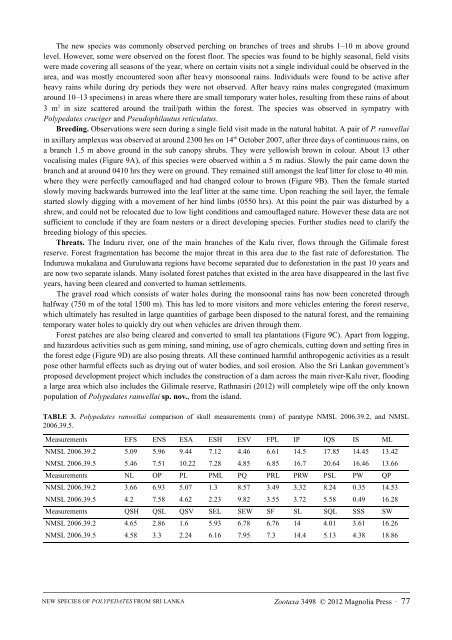Identification of Novel Species by Herpetological Foundation of Sri Lanka in Collaboration with Dilmah Conservation
Dilmah Conservation in collaboration with Herpetological Foundation of Sri Lanka has implemented a project on identification of new species of Herpetofauna, which will generate scientific evidence on their existence and promote conservation. This is the article published in Zootaxa Journal on the first new species identified as result of this research project – a species of Polypedates Tschudi …
Dilmah Conservation in collaboration with Herpetological Foundation of Sri Lanka has implemented a project on identification of new species of Herpetofauna, which will generate scientific evidence on their existence and promote conservation. This is the article published in Zootaxa Journal on the first new species identified as result of this research project – a species of Polypedates Tschudi …
You also want an ePaper? Increase the reach of your titles
YUMPU automatically turns print PDFs into web optimized ePapers that Google loves.
TERMS OF USE<br />
This pdf is provided <strong>by</strong> Magnolia Press for private/research use.<br />
Commercial sale or deposition <strong>in</strong> a public library or website is prohibited.<br />
The new species was commonly observed perch<strong>in</strong>g on branches <strong>of</strong> trees and shrubs 1–10 m above ground<br />
level. However, some were observed on the forest floor. The species was found to be highly seasonal, field visits<br />
were made cover<strong>in</strong>g all seasons <strong>of</strong> the year, where on certa<strong>in</strong> visits not a s<strong>in</strong>gle <strong>in</strong>dividual could be observed <strong>in</strong> the<br />
area, and was mostly encountered soon after heavy monsoonal ra<strong>in</strong>s. Individuals were found to be active after<br />
heavy ra<strong>in</strong>s while dur<strong>in</strong>g dry periods they were not observed. After heavy ra<strong>in</strong>s males congregated (maximum<br />
around 10–13 specimens) <strong>in</strong> areas where there are small temporary water holes, result<strong>in</strong>g from these ra<strong>in</strong>s <strong>of</strong> about<br />
3 m 2 <strong>in</strong> size scattered around the trail/path <strong>with</strong><strong>in</strong> the forest. The species was observed <strong>in</strong> sympatry <strong>with</strong><br />
Polypedates cruciger and Pseudophilautus reticulatus.<br />
Breed<strong>in</strong>g. Observations were seen dur<strong>in</strong>g a s<strong>in</strong>gle field visit made <strong>in</strong> the natural habitat. A pair <strong>of</strong> P. ranwellai<br />
<strong>in</strong> axillary amplexus was observed at around 2300 hrs on 14 th October 2007, after three days <strong>of</strong> cont<strong>in</strong>uous ra<strong>in</strong>s, on<br />
a branch 1.5 m above ground <strong>in</strong> the sub canopy shrubs. They were yellowish brown <strong>in</strong> colour. About 13 other<br />
vocalis<strong>in</strong>g males (Figure 9A), <strong>of</strong> this species were observed <strong>with</strong><strong>in</strong> a 5 m radius. Slowly the pair came down the<br />
branch and at around 0410 hrs they were on ground. They rema<strong>in</strong>ed still amongst the leaf litter for close to 40 m<strong>in</strong>.<br />
where they were perfectly camouflaged and had changed colour to brown (Figure 9B). Then the female started<br />
slowly mov<strong>in</strong>g backwards burrowed <strong>in</strong>to the leaf litter at the same time. Upon reach<strong>in</strong>g the soil layer, the female<br />
started slowly digg<strong>in</strong>g <strong>with</strong> a movement <strong>of</strong> her h<strong>in</strong>d limbs (0550 hrs). At this po<strong>in</strong>t the pair was disturbed <strong>by</strong> a<br />
shrew, and could not be relocated due to low light conditions and camouflaged nature. However these data are not<br />
sufficient to conclude if they are foam nesters or a direct develop<strong>in</strong>g species. Further studies need to clarify the<br />
breed<strong>in</strong>g biology <strong>of</strong> this species.<br />
Threats. The Induru river, one <strong>of</strong> the ma<strong>in</strong> branches <strong>of</strong> the Kalu river, flows through the Gilimale forest<br />
reserve. Forest fragmentation has become the major threat <strong>in</strong> this area due to the fast rate <strong>of</strong> deforestation. The<br />
Induruwa mukalana and Guruluwana regions have become separated due to deforestation <strong>in</strong> the past 10 years and<br />
are now two separate islands. Many isolated forest patches that existed <strong>in</strong> the area have disappeared <strong>in</strong> the last five<br />
years, hav<strong>in</strong>g been cleared and converted to human settlements.<br />
The gravel road which consists <strong>of</strong> water holes dur<strong>in</strong>g the monsoonal ra<strong>in</strong>s has now been concreted through<br />
halfway (750 m <strong>of</strong> the total 1500 m). This has led to more visitors and more vehicles enter<strong>in</strong>g the forest reserve,<br />
which ultimately has resulted <strong>in</strong> large quantities <strong>of</strong> garbage been disposed to the natural forest, and the rema<strong>in</strong><strong>in</strong>g<br />
temporary water holes to quickly dry out when vehicles are driven through them.<br />
Forest patches are also be<strong>in</strong>g cleared and converted to small tea plantations (Figure 9C). Apart from logg<strong>in</strong>g,<br />
and hazardous activities such as gem m<strong>in</strong><strong>in</strong>g, sand m<strong>in</strong><strong>in</strong>g, use <strong>of</strong> agro chemicals, cutt<strong>in</strong>g down and sett<strong>in</strong>g fires <strong>in</strong><br />
the forest edge (Figure 9D) are also pos<strong>in</strong>g threats. All these cont<strong>in</strong>ued harmful anthropogenic activities as a result<br />
pose other harmful effects such as dry<strong>in</strong>g out <strong>of</strong> water bodies, and soil erosion. Also the <strong>Sri</strong> <strong>Lanka</strong>n government’s<br />
proposed development project which <strong>in</strong>cludes the construction <strong>of</strong> a dam across the ma<strong>in</strong> river-Kalu river, flood<strong>in</strong>g<br />
a large area which also <strong>in</strong>cludes the Gilimale reserve, Rathnasiri (2012) will completely wipe <strong>of</strong>f the only known<br />
population <strong>of</strong> Polypedates ranwellai sp. nov., from the island.<br />
TABLE 3. Polypedates ranwellai comparison <strong>of</strong> skull measurements (mm) <strong>of</strong> paratype NMSL 2006.39.2, and NMSL<br />
2006.39.5.<br />
Measurements EFS ENS ESA ESH ESV FPL IP IQS IS ML<br />
NMSL 2006.39.2 5.09 5.96 9.44 7.12 4.46 6.61 14.5 17.85 14.45 13.42<br />
NMSL 2006.39.5 5.46 7.51 10.22 7.28 4.85 6.85 16.7 20.64 16.46 13.66<br />
Measurements NL OP PL PML PQ PRL PRW PSL PW QP<br />
NMSL 2006.39.2 3.66 6.93 5.07 1.3 8.57 3.49 3.32 8.24 0.35 14.53<br />
NMSL 2006.39.5 4.2 7.58 4.62 2.23 9.82 3.55 3.72 5.58 0.49 16.28<br />
Measurements QSH QSL QSV SEL SEW SF SL SQL SSS SW<br />
NMSL 2006.39.2 4.65 2.86 1.6 5.93 6.78 6.76 14 4.01 3.61 16.26<br />
NMSL 2006.39.5 4.58 3.3 2.24 6.16 7.95 7.3 14.4 5.13 4.38 18.86<br />
NEW SPECIES OF POLYPEDATES FROM SRI LANKA<br />
Zootaxa 3498 © 2012 Magnolia Press · 77















